watercolour painting pdf
Summary
Discover stunning watercolour painting PDF guides, packed with tutorials, techniques, and inspiration to elevate your art.
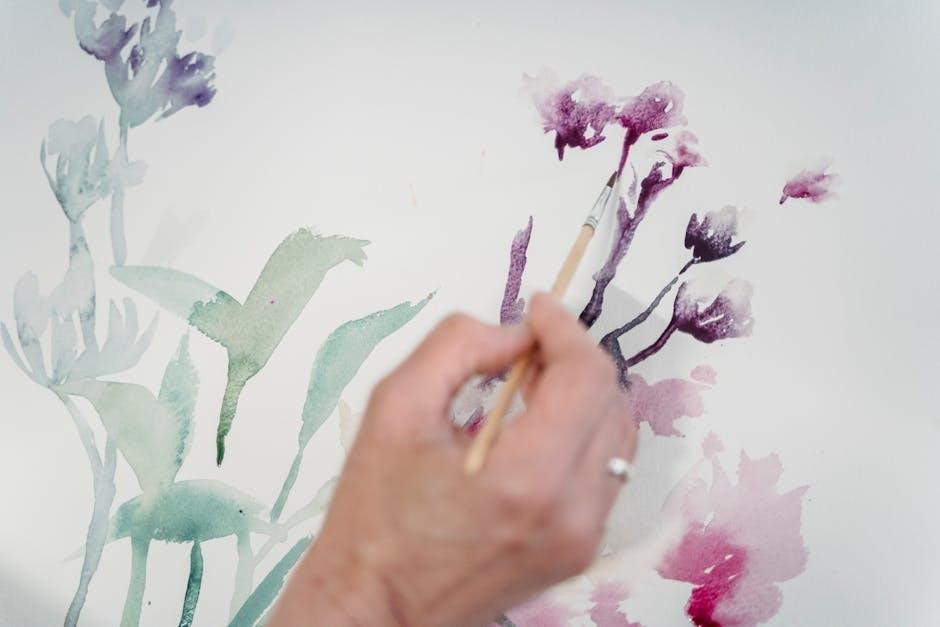
Watercolour painting is a vibrant art form offering unique transparency and fluidity․ Discover its basics through a comprehensive PDF guide, covering essential techniques, materials, and inspiration for creating stunning works․ Perfect for beginners, it provides a clear path to mastering this beautiful medium․
What is Watercolour Painting?
Watercolour painting is a delicate and expressive art form that uses water-soluble pigments to create transparent and fluid compositions․ Unlike oil or acrylic painting, watercolours rely on the white of the paper to shine through, giving the artwork a sense of lightness and spontaneity․ The medium consists of pigments suspended in a water-based solution with a binding agent, typically gum arabic, which adheres the colours to the paper․ This technique allows for soft blends, intricate details, and vibrant hues, making it ideal for capturing landscapes, portraits, and abstract designs․ Watercolour painting requires precision and patience, as the transparency of the paint makes it difficult to correct mistakes․ Its unique qualities have made it a beloved medium for artists across centuries, offering endless opportunities for creativity and experimentation․
A Brief History of Watercolour Painting
Watercolour painting has a rich history dating back thousands of years, with early examples found in ancient Egyptian and Chinese art․ The medium evolved significantly during the Renaissance, becoming a popular choice for botanical and miniature works․ By the 18th century, watercolours gained prominence in Britain, where artists like J․M․W․ Turner and John Constable used the technique to capture landscapes and light․ The 19th century saw the rise of the Pre-Raphaelites, who further elevated watercolour’s expressive potential․ Today, watercolour remains a beloved medium, celebrated for its transparency and fluidity․ Its enduring appeal lies in its ability to blend tradition with modern creativity, inspiring artists worldwide to explore its unique qualities․ This historical journey is beautifully documented in various PDF guides, offering insights into its evolution and artistic impact․
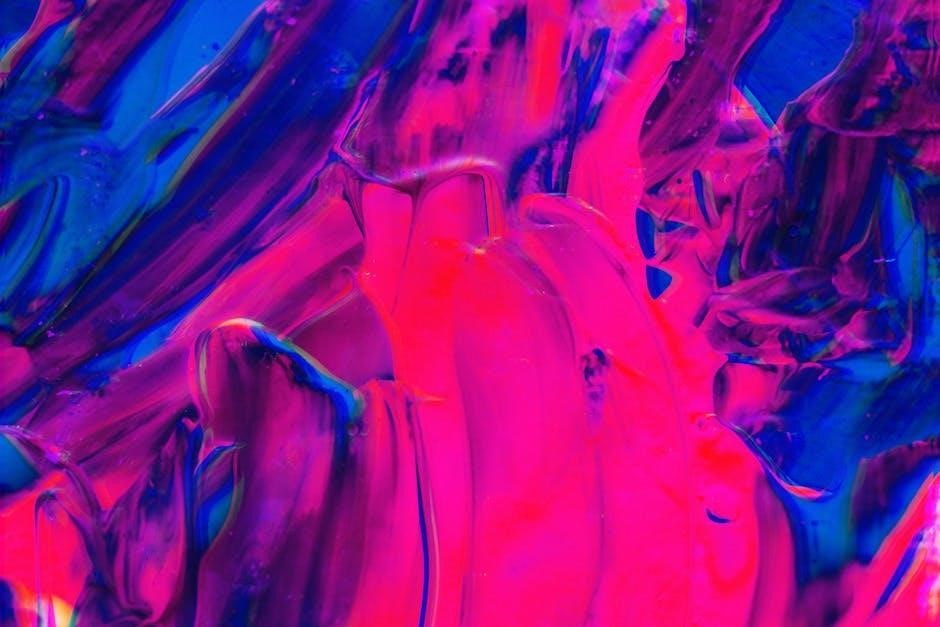
Materials Needed for Watercolour Painting
Essential materials include high-quality watercolour paints, various brushes, textured paper, a sturdy palette, and water containers․ These tools, along with optional accessories, are detailed in comprehensive PDF guides for artists․
Essential Paints and Pigments
High-quality watercolour paints are the cornerstone of this medium․ Choose lightfast, vibrant pigments that ensure durability and colour retention․ Professional-grade paints, like those from Daniel Smith, offer superior intensity and blending capabilities․ Student-grade paints are cost-effective for beginners but may lack the richness of professional options․ Look for paints with high pigment load and minimal fillers․ A basic palette should include primary colours, blacks, and whites, allowing for versatile mixing․ Consider purchasing paints in tube form for better value and ease of use․ A comprehensive PDF guide can help you select the right pigments and understand their properties, ensuring your work stands the test of time․ Always invest in reputable brands to achieve the best results in your watercolour journey․
Brushes: Types and Sizes
Selecting the right brushes is crucial for watercolour painting․ Natural hair brushes, such as sable or squirrel, are ideal for watercolour due to their excellent water-holding capacity․ Synthetic brushes offer a more affordable alternative and are easier to maintain․ Round brushes are perfect for fine details and linework, while flat brushes are best for broad washes and covering large areas․ Mop brushes create soft, blended effects, and detail brushes are great for small, intricate work․ Sizes range from 0 (for fine lines) to 12 (for bold strokes)․ A comprehensive PDF guide can help you choose the right brushes for your needs, ensuring optimal performance and versatility in your watercolour practice․ Proper care, including regular cleaning and storage, will extend the life of your brushes․
Watercolour Paper:Textures and Sizes
Watercolour paper is a cornerstone of the medium, available in various textures and sizes to suit different artistic needs․ The three main textures are hot press, cold press, and rough․ Hot press paper is smooth, ideal for fine details and even washes, while cold press has a subtle texture, perfect for blending and expressive work․ Rough paper offers a heavily textured surface, great for creating dynamic, organic effects․ Papers are typically sold in standard sizes such as A4, A3, and custom sheet sizes․ Weight is also crucial, with 300gsm being professional grade and 200gsm suitable for practice․ A comprehensive PDF guide can provide detailed insights into selecting the right paper for your watercolour projects, ensuring your artwork lasts for years․
Palettes and Additional Accessories
A well-organized palette is essential for watercolour painting, allowing easy access to colours and mixing․ Disposable palettes are convenient for quick sessions, while reusable ones, like porcelain or plastic, offer durability․ Additional accessories like spray bottles, masking fluid, and tape help control water and pigment flow․ Sponges and blotting paper are useful for creating textures and absorbing excess water․ A comprehensive PDF guide can detail how to set up your palette and utilize these tools effectively, ensuring efficiency and creativity in your artistic process․ Properly equipping your workspace enhances both the quality and enjoyment of your watercolour journey․
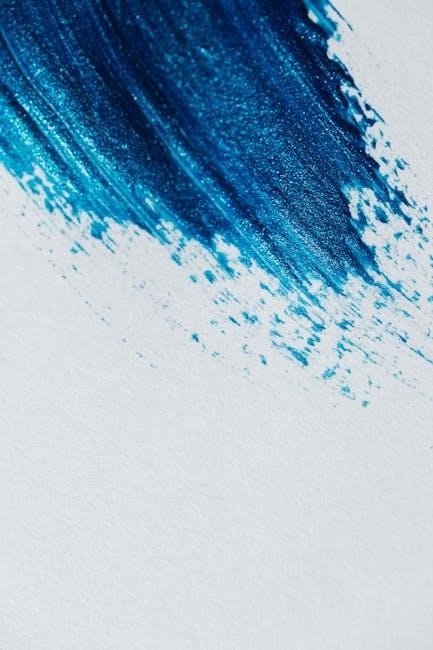
Basic Techniques in Watercolour Painting
Mastering foundational techniques like wet-on-wet, washes, and drybrush is key to watercolour painting․ A detailed PDF guide can help you learn these methods step-by-step, ensuring a strong artistic foundation․
Wet-on-Wet Technique
The wet-on-wet technique involves applying wet paint to wet paper, creating soft, blended transitions․ This method is ideal for capturing subtle shifts in color and light, particularly in skies and water․ By layering pigments without waiting for the surface to dry, artists achieve fluid, spontaneous effects․ It’s a cornerstone of watercolour painting, offering dynamic results for landscapes, florals, and abstract works․ A detailed PDF guide can provide step-by-step tutorials, helping beginners master this essential skill․ Practice this technique to enhance your ability to create fresh, vibrant, and expressive watercolour artwork with ease and confidence․
Wash: The Foundation of Watercolour
A wash is a fundamental technique in watercolour painting, involving the application of a thin layer of transparent paint across a large area․ It serves as the foundation for many compositions, creating soft, even backgrounds and setting the overall tone of a piece․ Washes can be flat, graduated, or textured, each offering unique effects․ Properly executed washes require the right balance of water and pigment, as well as careful planning to avoid muddying the colours․ A detailed PDF guide can provide practical tips for mastering this essential skill, including how to mix the perfect consistency and control bleeds․ With practice, washes become the backbone of your watercolour work, enabling you to achieve delicate, luminous results․
Drybrush: Creating Textures
The drybrush technique in watercolour painting involves using a nearly dry brush to create textured, rough effects․ By dragging the brush across the paper with minimal water, artists can achieve lifelike depictions of grass, tree bark, and rocky surfaces․ This method is particularly useful in landscape painting to add depth and realism․ To master drybrushing, load the brush with pigment and wipe off excess moisture before applying firm pressure․ Practice on different paper textures to enhance the effect․ Many PDF guides offer step-by-step tutorials and examples to help refine this versatile technique, making it easier to incorporate into your artistic repertoire․
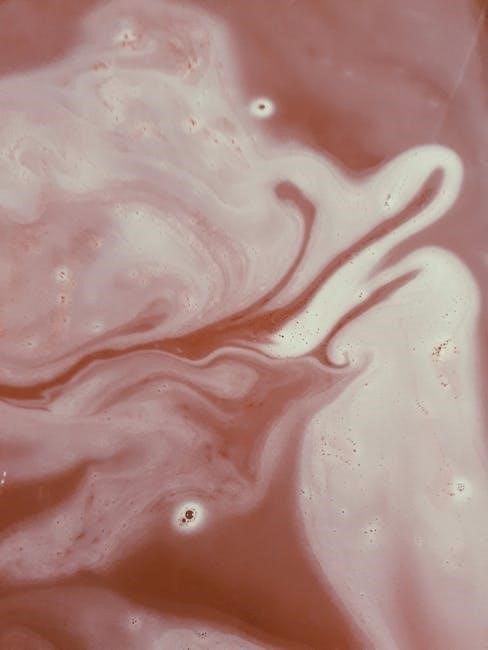
Advanced Techniques in Watercolour Painting
Explore advanced methods like glazing and negative painting to add depth and complexity․ These techniques, detailed in PDF guides, help artists achieve professional-level watercolour results with precision and creativity․
Glazing: Layering for Depth
Glazing is an advanced watercolour technique that involves applying multiple thin, transparent layers of paint to achieve deep, rich colours and intricate details․ This method allows artists to build up luminosity and depth in their work, creating a sense of dimensionality․ By layering washes, painters can blend hues subtly and experiment with colour saturation․ Many PDF guides provide step-by-step tutorials on glazing, offering tips on selecting the right pigments and brushes for optimal results․ These resources often include examples of how glazing can transform landscapes, portraits, and abstract pieces․ With practice, artists can master this technique to add sophistication and complexity to their watercolour paintings, as highlighted in detailed PDF resources․
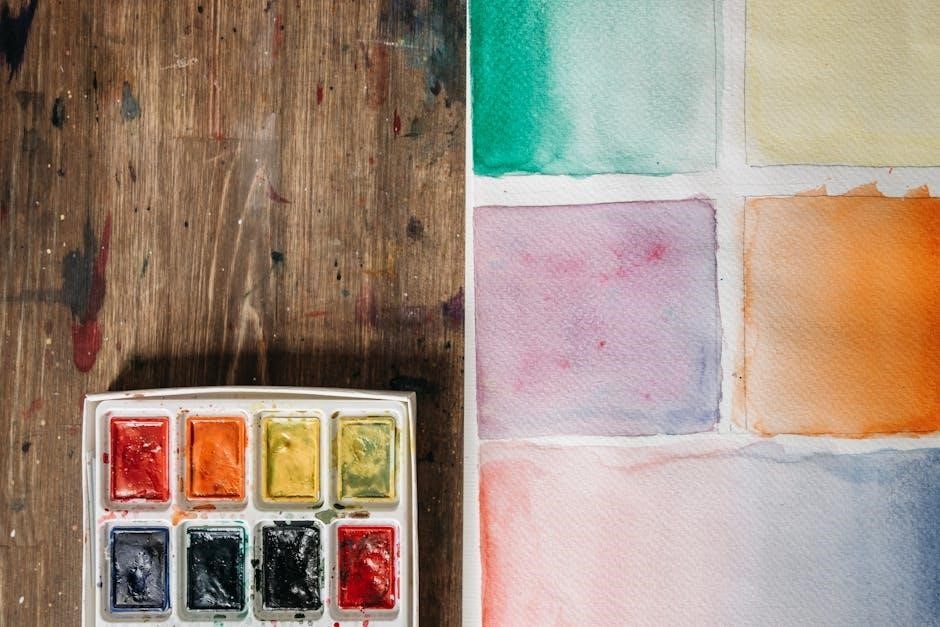
Negative Painting: Subtracting Colour
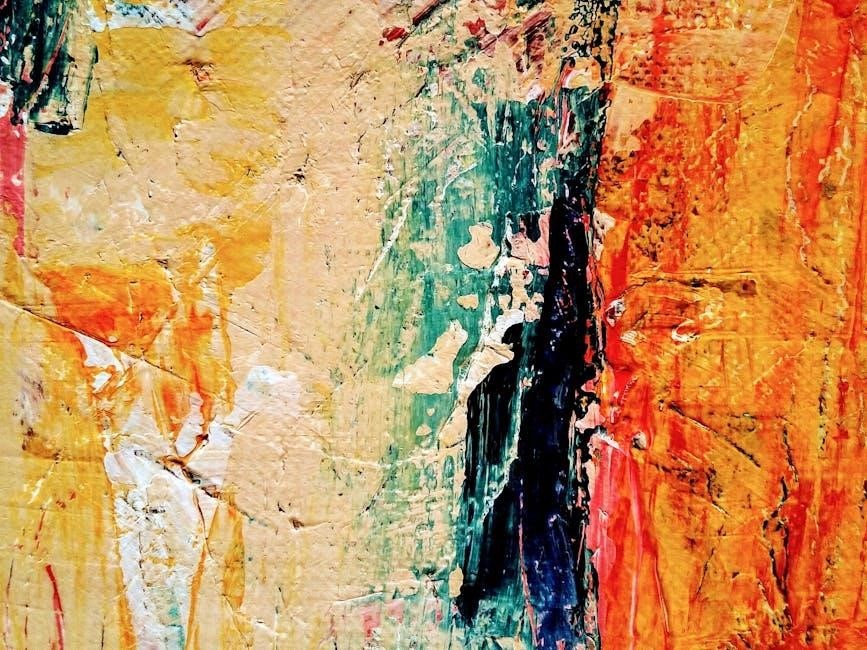
Negative painting is a sophisticated watercolour technique that involves removing paint or leaving areas of the paper unpainted to create highlights, details, and subtle textures․ This method often requires working backwards, as artists carefully preserve or uncover white spaces to achieve the desired effects․ It is particularly effective for capturing delicate elements like water, skies, and foliage․ Many PDF guides offer detailed lessons on negative painting, including step-by-step examples and practical exercises․ These resources emphasize the importance of planning and precision, as well as the use of masking fluids to protect areas of the paper․ By mastering negative painting, artists can add nuance and complexity to their work, creating striking contrasts and visual interest in their compositions, as demonstrated in various PDF tutorials․
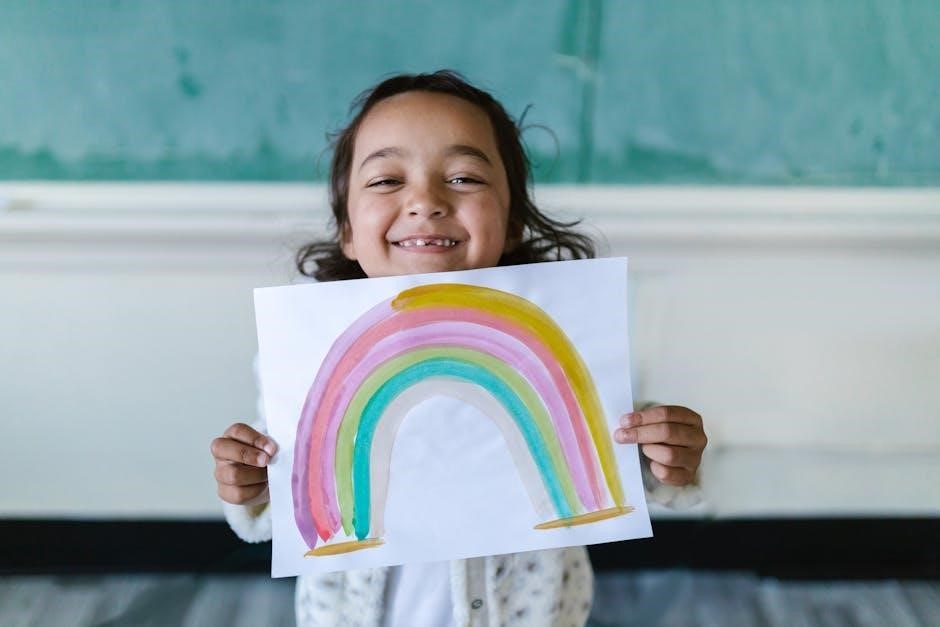
Tutorials and Projects for Practice
Enhance your watercolour skills with practical tutorials and projects from PDF guides, offering step-by-step instructions for landscapes, portraits, and abstract art to master various techniques and styles․
Painting Landscapes: Skies and Water
Mastering the depiction of skies and water is essential for captivating landscape paintings․ A watercolour PDF guide offers detailed tutorials on creating soft, gradient skies using wet-on-wet techniques and layering glazes for depth․ Learn to capture the movement and reflection of water with drybrush textures and subtle colour blending․ Start with simple exercises like painting a serene sunset or a calm lake, gradually progressing to more complex scenes like ocean waves or misty mornings․ Tips include using light washes for sky bases and allowing layers to dry before adding details․ Practice these techniques to bring life and realism to your landscape compositions, making your artwork truly immersive and visually striking․
Portraits: Capturing Skin Tones
Capturing realistic skin tones in watercolour portraits requires precision and layering․ A watercolour PDF guide provides step-by-step instructions for mixing flesh tones using pigments like Burnt Sienna, Ultramarine Blue, and Yellow Ochre․ Learn to create depth by layering glazes and subtle washes, starting with a light base tone and gradually building warmth and dimension․ Techniques include wet-on-wet blending for soft transitions and drybrush for textures like hair or fabric․ Practice exercises focus on painting individual facial features, such as eyes and lips, to achieve lifelike expressions․ The guide also offers tips for maintaining transparency and avoiding muddiness, ensuring your portraits radiate vitality and emotion․ These lessons are perfect for artists aiming to master the delicate art of watercolour portraiture․
Abstract Art: Expressive Techniques
Unleash creativity with abstract watercolour techniques, perfect for expressive art․ A watercolour PDF guide explores methods like wet-on-wet, salt sprinkling, and blow-drying to create dynamic, textured effects․ Learn to experiment with vibrant pigments and fluid movements, capturing emotion through spontaneous brushstrokes․ The guide offers lessons on layering transparent washes for ethereal backgrounds and using gestural painting to convey energy․ Discover how to balance chaos and control, creating unique, non-representational pieces․ Tips on embracing happy accidents and interpreting abstract forms will inspire your artistic journey․ These techniques empower artists to explore the limitless possibilities of abstract expression in watercolour, making it an invaluable resource for those seeking creative freedom and innovation in their work․
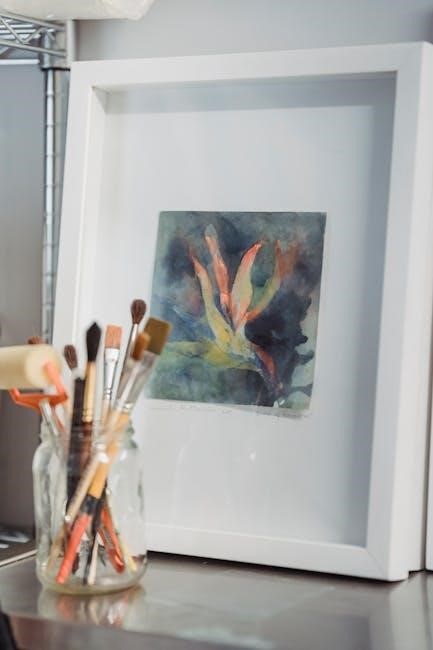
Digital Tools for Watercolour Artists
Enhance your watercolour practice with digital tools like Procreate and Krita, offering realistic simulations and custom brushes for artistic expression․ These tools expand creative possibilities for modern artists․
Procreate: Digital Watercolour Simulation
Procreate offers an exceptional digital watercolour experience, mimicking traditional techniques with remarkable accuracy․ Its extensive brush library includes watercolour-specific tools that replicate the texture and blending of physical paints․ Artists can achieve soft blends, delicate washes, and vibrant layers using the app’s intuitive interface․ Procreate’s watercolour simulation supports wet-on-wet and glazing effects, allowing for dynamic and expressive artwork․ The app also features customizable brushes, enabling users to tailor their tools to suit their artistic style․ With Procreate, artists can experiment without the mess of traditional media, enjoying unlimited undo/redo options and non-destructive layer masks․ Its high-resolution export capabilities make it ideal for professional projects․ Available on iPad, Procreate is a powerful companion for watercolour enthusiasts, bridging the gap between digital and traditional art seamlessly․
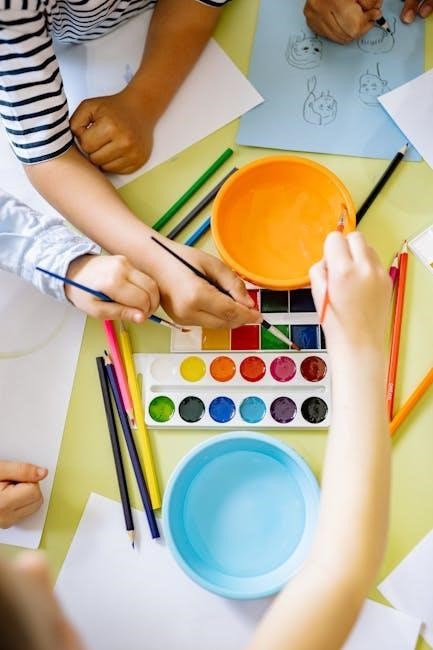
Krita: Custom Brushes for Watercolour Effects
Krita stands out as a powerful digital painting tool with exceptional custom brush capabilities, ideal for achieving watercolour effects․ Its brush engines, such as the watercolor and pigmento engines, simulate the blending and texture of traditional watercolour paints․ Artists can adjust parameters like flow, opacity, and blending modes to mimic the fluidity of watercolours․ Krita also supports layer masks and non-destructive editing, allowing for precise control over intricate details․ The software’s ability to create custom brushes ensures that users can replicate the unique characteristics of watercolour painting digitally․ Additionally, Krita’s open-source nature makes it accessible to artists of all levels, offering a cost-effective solution for exploring watercolour techniques in a digital environment․ With its robust features, Krita is a popular choice among digital artists seeking to capture the essence of watercolour painting․
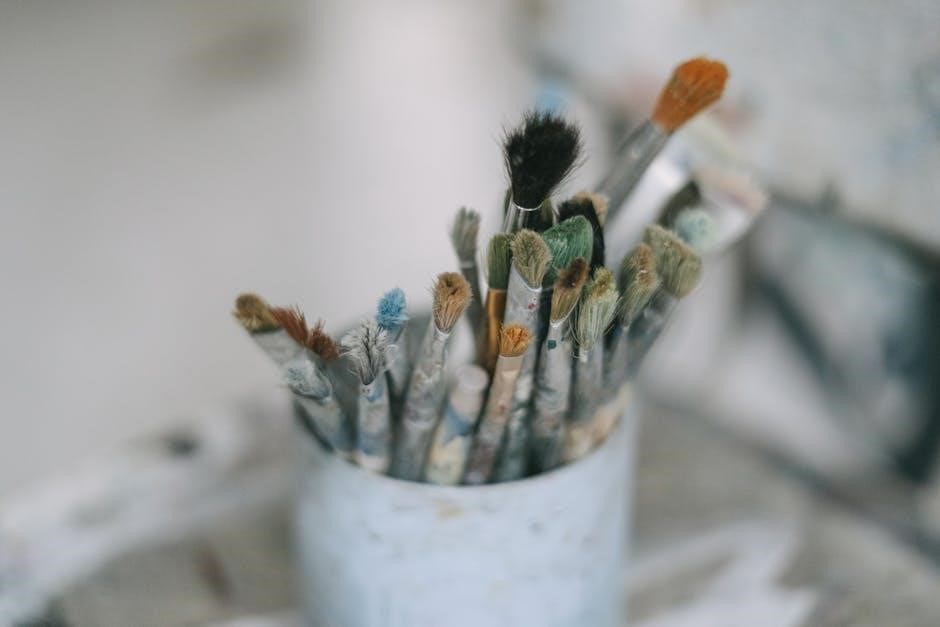
PDF Content for Watercolour Painting
Watercolour PDF guides provide detailed tutorials, sketches, and finished paintings․ They cover essential techniques, materials, and creative inspiration, helping artists refine their skills and explore new artistic possibilities․
What to Expect in a Watercolour PDF Guide
A watercolour PDF guide typically offers a comprehensive overview of the medium, including step-by-step tutorials, detailed sketches, and high-quality images of finished paintings․ These guides often cover essential topics such as choosing the right materials, mastering basic techniques like washes and wet-on-wet, and understanding colour theory․ Many PDFs also provide practical tips for beginners, such as setting up a workspace and overcoming common challenges․ Additionally, they may include inspirational content, showcasing various styles and subjects, from landscapes to portraits․ Some guides even offer downloadable resources, like printable palettes or practice exercises, to enhance the learning experience․ Whether you’re a novice or looking to refine your skills, a watercolour PDF guide is an invaluable resource for artistic growth․
Tips for Beginners: Getting Started
Starting with watercolour painting can be both exciting and intimidating, but with the right approach, beginners can quickly build confidence․ Begin by investing in quality materials, such as professional-grade paints and brushes, as they offer better pigment intensity and durability․ Practice basic techniques like washes and wet-on-wet to understand how water and pigment interact․ Sketch your composition lightly before painting to ensure proper proportions․ Start with simple subjects, like skies or flowers, to get accustomed to the medium․ Remember, watercolour thrives on spontaneity, so embrace happy accidents and don’t overwork your painting․ Watch tutorials and seek guidance from experienced artists to refine your skills․ Most importantly, practice regularly and enjoy the creative journey!